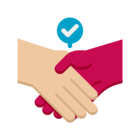Gabriela Servidone, AIMMS modeling expert at UniSoma, explains why she started studying usability and how it has changed her approach to projects with customers. She also shares how she and her colleagues transitioned customers into WebUI apps, and why she is excited about using WebUI to its full potential.
A lot of developers struggle with making their model easy to use for a typical end user. How did you start learning about usability concepts?
I read a few books about usability. I was able to understand the main concepts, and I use them every day in my work.
When you read these, at first it seems obvious. You wonder why it needs to be written. But, in your daily work you forget these simple things. For example, if you have buttons Cancel and OK, and they are in the "wrong" or unusual position. This little detail makes it really hard for your users!
So, it's worthwhile to review these fundamentals and really try to follow them. And it doesn't just mean the UI.
I presented recently at a student hackathon event, and I told them: You can have the best model in the world, but if it's not pretty enough, or usable enough, or not easy to understand, people will not use it. It's better to have a "good" model that is usable than a "great" model that is impossible for the user to understand.
Reading list: Laws of UX (Jon Yablonski), Design of Everyday Things (Don Norman), Don't Make Me Think (Steve Krug), Don Norman videos (N/N group).
How do you get an understanding of the end user, to make it easier for them to use your application?
I think about what it would be like if I were the user—I have a stressful day, I don't have the time to go find someone to help me for every little thing. And so I try to anticipate their needs.
I provide the information they need and make documentation, troubleshooting tips, and everything I can to make the user independent from me.
The app is not for me, it's for them. If they aren't comfortable with using the app on a basic level, how can they go to a higher level and ask me about the optimization? If they're stuck on a usability problem, they can't get to the what-if scenarios for their specific business case, which is really what I designed the app for.
That's my motivation; I want them to be confident using the app the way they need to.
How have you shared your learnings with your colleagues?
I studied some Design Systems, and I tried to apply the idea in UniSoma. Instead of a separate design system, I made WebUI project templates for our developers.
When our developers need to make a new WebUI project, I already have a project pre-made with a Home page, Workflow, and so on. I make steps to plug in a side panel, put in a string parameter, and so on. If they don't use it, the code is just "standby", but they can go from there. This way they don't need to do everything, and can get started quickly. And, it means they are learning to use the features in the intended way.
We've made a big effort to make WebUI easy-to-develop and easy-to-use, but many customers are still more comfortable with their old WinUI apps. How did transitioning to WebUI apps affect adoption and user satisfaction?
I really wanted to use WebUI as it got better and better. Whenever a new developer joined us, I trained them in WebUI so they could feel confident using it. Once we had the knowledge, we had to sell it to the customers.
At first it took some convincing to our long-time customers. The first WebUI apps were pretty small, such as a dashboard for managers. The customers liked it, but without a portfolio of WebUI apps, it was a hard sell.
They weren't ready for a project entirely in WebUI, so we did a POC: a prototype with no functionality. We did a workflow, graphs, widget actions, page actions, filters...everything. They loved it!
After that we started the first full WebUI app, and we started getting customer compliments. Up to now, we've developed three full WebUI apps, though they are not fully complete yet.
The second full-WebUI project was pretty big. We had input pages and we added side panels with documentation and troubleshooting. The customer liked it, especially the Workflow. So we will probably use more WebUI for this customer.
Are there any AIMMS features you find very helpful in making better apps for users? How has it changed in the past couple years with the "UX 2.0" updates?
I use Workflow in almost every app I do in WebUI. Users have a lot to work with: master data, transactional data...if they don't know what to do first, I can control what order things go in.
I also like to use the side panels for filtering, and for documentation. It's nice to have these available on the same page but not in the way.
I really like the new graphs, especially bar-line graphs. This simple detail gives a huge advantage in some cases. Most customers normally use Excel or Power BI to analyze data, so having this familiar feature is reassuring.
Since launching WebUI, we've made a commitment to continuous delivery of new features to give you and your customers the best app experience on top of your model. UX 2.0 has focused on cutting edge usability features and a sleek appearance to give your customers an ultra-modern user experience.
See the latest WebUI Product Updates.


